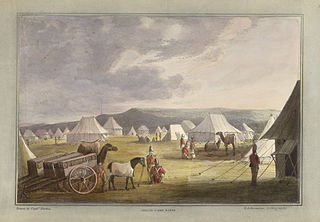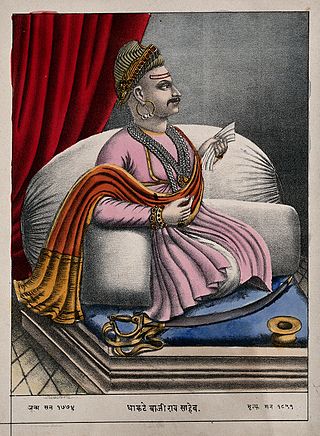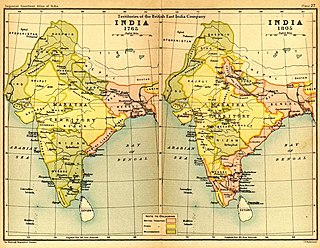
The Third Battle of Panipat took place on 14 January 1761 between the Maratha Confederacy and the invading army of the Durrani Empire. The battle took place in and around the city of Panipat, approximately 97 kilometres (60 mi) north of Delhi. The Afghans were supported by three key allies in India: Najib ad-Dawlah who persuaded the support of the Rohilla chiefs, elements of the declining Mughal Empire, and most prized the Oudh State under Shuja-ud-Daula. The Maratha army was led by Sadashivrao Bhau, who was third-highest authority of the Maratha Confederacy after the Chhatrapati and the Peshwa. The bulk of the Maratha army was stationed in the Deccan Plateau with the Peshwa.

The Third Anglo-Maratha War (1817–1819) was the final and decisive conflict between the British East India Company and the Maratha Empire in India. The war left the Company in control of most of India. It began with an invasion of Maratha territory by British East India Company troops, and although the British were outnumbered, the Maratha army was decimated. The troops were led by Governor General Hastings, supported by a force under General Thomas Hislop. Operations began against the Pindaris, a band of Muslim mercenaries and Marathas from central India.

Shaniwar Wada is a historical fortification in the city of Pune, India.

Balaji Baji Rao, often referred to as Nana Saheb I, was the 8th Peshwa of the Maratha Confederacy. He was appointed as Peshwa in 1740 upon the death of his father, the Peshwa Bajirao I.

The First Anglo-Maratha War (1775–1782) was the first of three Anglo-Maratha Wars fought between the British East India Company and Maratha Confederacy in India. The war began with the Treaty of Surat and ended with the Treaty of Salbai. The war, fought in between Surat and Poona, saw British defeat and restoration of positions of both the parties before the war. Warren Hastings, the first Governor-General of Bengal decided not to attack Poona directly.

Madhavrao I was the 9th Peshwa of the Maratha Confederacy. During his tenure, the Maratha Confederacy fully recovered from the losses they suffered during the Third Battle of Panipat, an event known as Maratha Resurrection.

Narayanrao was the 10th Peshwa of the Maratha Confederacy from November 1772 until his assassination in August 1773. He married Gangabai Sathe who later gave birth to Sawai Madhavrao.

Baji Rao II was the 13th and the last Peshwa of the Maratha Confederacy. He governed from 1795 to 1818. He was installed as a puppet ruler by the Maratha nobles, whose growing power prompted him to flee his capital Poona and sign the Treaty of Bassein (1802) with the British. This resulted in the Second Anglo-Maratha War (1803–1805), in which the British emerged victorious and re-installed him as the titular Peshwa. In 1817, Baji Rao II joined the Third Anglo-Maratha War against the British, after they favoured the Gaekwad nobles in a revenue-sharing dispute. After suffering several battle defeats, the Peshwa surrendered to the British, and agreed to retire in return for an estate at Bithoor and an annual pension.

Raghunathrao Bhat, also known as Ragho Ballal or Ragho Bharari, was the 11th Peshwa of the Maratha Empire for a brief period from 1773 to 1774. He was known among the Hindus for his extremely successful North-western campaign of 1757-58 and for his works to liberate the Hindu holy places of Kashi and Ayodhya.

Malhar Rao Holkar was a noble subedar of the Maratha Empire, in present-day India. He was one of the early officers along with Ranoji Scindia to help spread the Maratha rule to northern states and was given the estate of Indore to rule by the Peshwas, during the reign of the Maratha emperor Shahu I. He was founder of the Holkar dynasty that ruled Malwa.

Ram Shastri Prabhune was the Chief Justice in the apex court of the Maratha Empire in the latter half of the 18th century, during the heyday of that empire. He is best remembered for having passed strictures against the sitting Peshwa of the time for instigating murder. Ram Shastri's integrity in public affairs is regarded as a model for all times.

The Maratha Conquests were a series of conquests in the Indian subcontinent which led to the building of the Maratha Empire. These conquests were started by Shivaji in 1659, from the victory at the Battle of Pratapgad against Bijapur. The expansion of the empire was limited and interrupted by the Mughal conquests of south India by Mughal emperor Aurangzeb. Marathas were forced to defend their territories against the overwhelmingly strong Mughal army in the 27 years long Deccan wars. They were able to defend their territories and gain an upper hand over Mughals in the sustained conflict.

Sadashivrao Bhau Peshwa was son of Chimaji Appa and Rakhmabai and the nephew of Baji Rao I. He was a finance minister during the reign of Maratha emperor Rajaram II. He led the Maratha army at the Third Battle of Panipat.

Madhavrao II was the 12th Peshwa of the Maratha Empire in India, from his infancy. He was known as Sawai Madhav Rao or Madhav Rao Narayan. He was the posthumous son of Narayanrao Peshwa, murdered in 1773 on the orders of Raghunathrao. Madhavrao II was considered the legal heir, and was installed as Peshwa by the Treaty of Salbai in 1782 after First Anglo-Maratha War.
Gopikabai was Peshwin of Maratha Empire, as the wife of Peshwa Balaji Baji Rao. She had a very orthodox religious upbringing and belief. After the death of Nanasaheb Peshwa, she tried to expand her power over the Peshwa and the administration. She influenced her son Madhavrao Peshwa, who by sidelining Raghunathrao at her urging, assumed control. However, after trying to interfere in administrative matters, namely to save her brother from punishment, she was confined to Nashik. In 1773 she was freed after the death of Madhavarao and went back to Pune. Afterwards, Gopikabai became part of the priestly class. She developed a rivalry with other women in the Peshwa's household. She was the mother of three successive Peshwas.
Anandibai was a Peshwa Queen and the wife of Raghunathrao, the 11th Peshwa of the Maratha Empire. In August 1773, she successfully plotted the death of her nephew, the 17-year-old Peshwa Narayanrao. Her husband was acting regent at the time and next in line for the throne, at the time of Narayanrao's death.
The Bhat Peshwa family earlier known as Bhat family is a prominent Indian Chitpavan Brahmin family who dominated India for around 100 years in the late 18th century and early 19th century. Most of the members in this family were the Peshwas in the Peshwa Era of the Maratha Empire, and Peshwa later became their family name. During their regime, most of the Indian subcontinent was under their control. The last Peshwa, Baji Rao II, was defeated by the British East India Company in the Third Anglo-Maratha War in 1818. The territory was annexed to the British East India Company's Bombay Presidency, and he was pensioned.

Khanderao Holkar was the only son of Malhar Rao Holkar, the founder of the Holkar dynasty of Indore, and Gautama Bai. He was the husband of Ahilyabai Holkar. He served as a Maratha Sardar and fought several campaigns on behest of the Maratha empire.
Sakharam Hari Gupte was born in Chandraseniya Kayastha Prabhu (CKP) family, and was the commander and tipnis (secretary) of Peshwa Bajirao I. For few years he worked under Peshwa Nanasaheb and then became the General of Raghunathrao Peshwa. He was responsible for conquering Attock on the banks of the Indus and repelling the Durrani ruler, Ahmad Shah Abdali out of India in the 1750s.

The Assassination of Narayan Rao occurred on 30 August 1773, when the 18 year old Peshwa of the Maratha Confederacy Narayan Rao, was assassinated. This plot was carried out During the Ganesh Chaturthi Festival that took place from 21 to 31 August. This was plotted by his uncle Raghunath Rao and his wife Anandibai. They used members of the Kalbelia tribe as assassins. Raghunath Rao was the next in line for the throne, at the time of Narayan Rao's death. Narayan Rao and his servant Chapaji Tilekar were both killed. A total of eleven people had been killed in the palace, seven of them were Brahmins, two servants, two maids. One cow was also killed.















